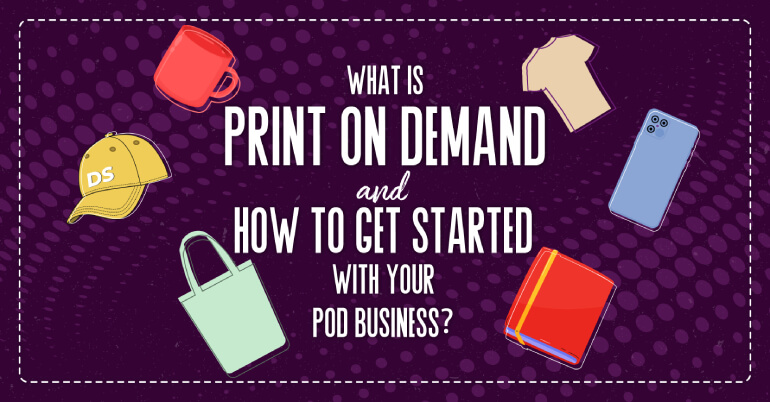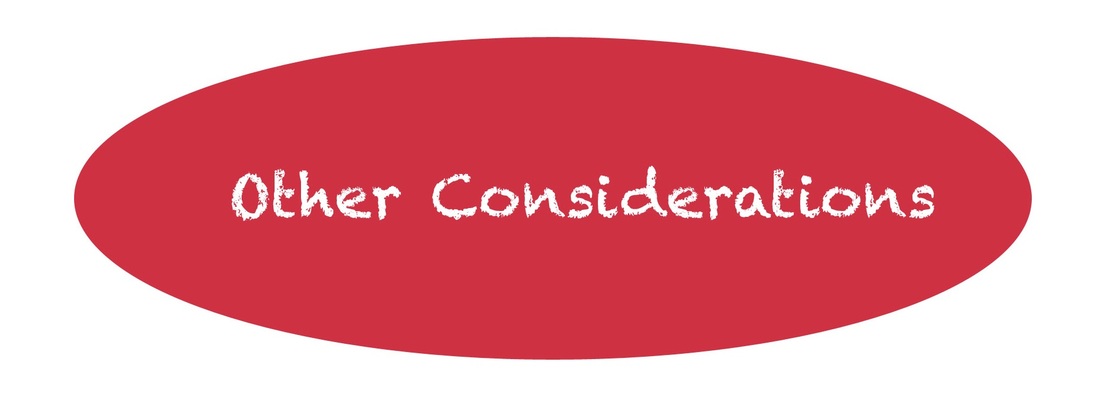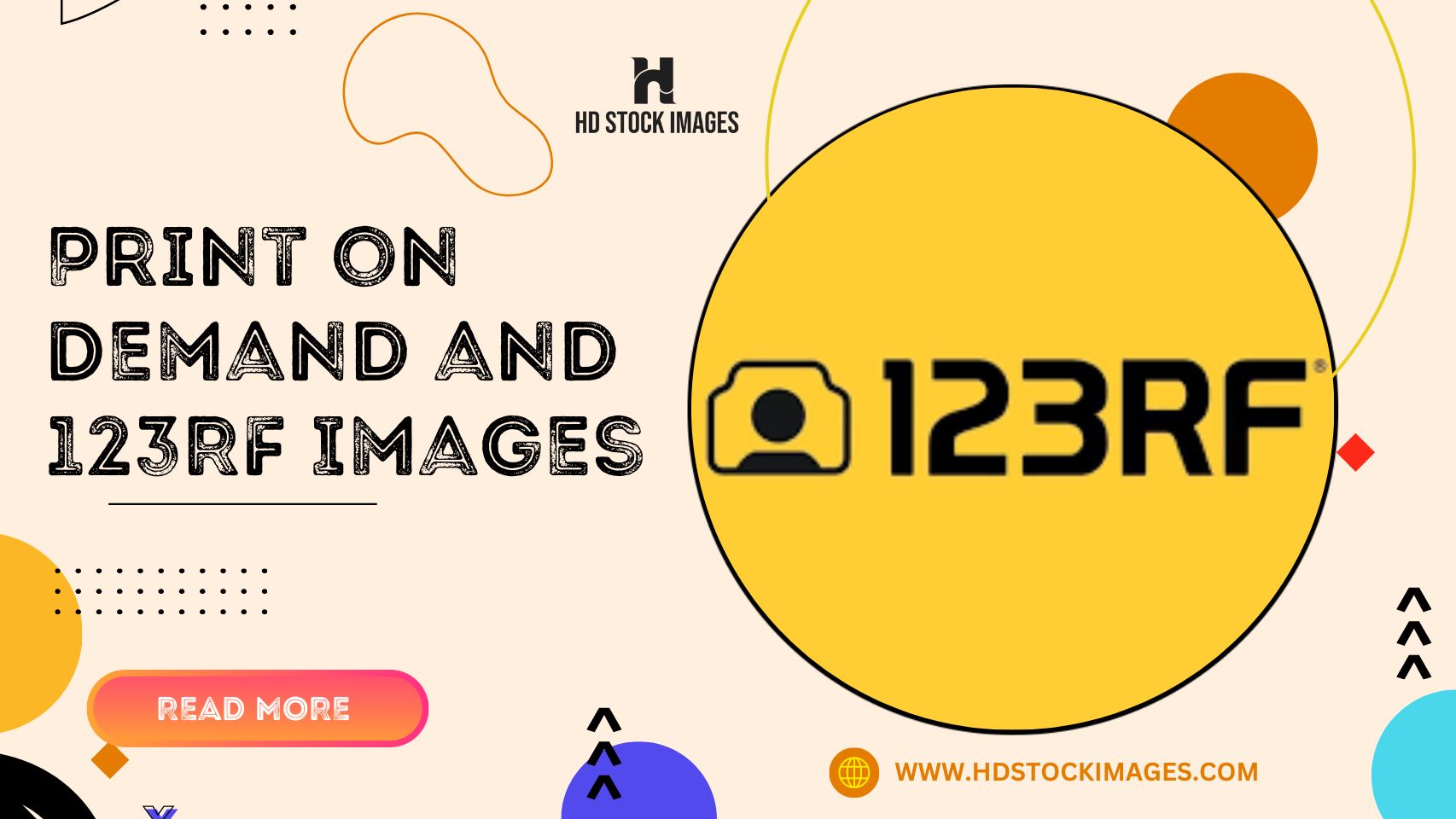1: Introduction:
Print on Demand (POD) is a business model that revolutionizes the way custom-designed products are created and manufactured. Unlike traditional methods of production, POD allows for on-demand printing and manufacturing, eliminating the need for bulk production. In the context of using images for POD products, understanding usage rights and licensing opportunities is vital. 123RF Images is a prominent stock photography platform that offers a vast collection of images, illustrations, and vectors for licensing. This article explores the fundamentals of POD and delves into the intricacies of usage rights and licensing, with a specific focus on leveraging 123RF Images to enhance print-on-demand endeavors.Also Read This: Printing Edible Images for Cookies
2: Print on Demand (POD):
 Print on Demand (POD) is a modern business model that enables individuals and companies to create custom-designed products without the need for upfront inventory or production costs. With POD, products like t-shirts, mugs, posters, and more are manufactured only when an order is placed, allowing for greater flexibility and cost-effectiveness.This on-demand production method has gained popularity due to its convenience and accessibility, empowering entrepreneurs, artists, and designers to bring their creations to market with ease. By leveraging POD services, individuals can focus on the creative aspects of their business while leaving the printing, packaging, and shipping logistics to specialized providers.This video shows how to Print on Demand and 123RF Images:https://www.youtube.com/watch?v=8a4JBcKQOv8&pp=ygVUUHJpbnQgb24gRGVtYW5kIGFuZCAxMjNSRiBJbWFnZXM6IEV4cGxvcmluZyBVc2FnZSBSaWdodHMgYW5kIExpY2Vuc2luZyBPcHBvcnR1bml0aWVz
Print on Demand (POD) is a modern business model that enables individuals and companies to create custom-designed products without the need for upfront inventory or production costs. With POD, products like t-shirts, mugs, posters, and more are manufactured only when an order is placed, allowing for greater flexibility and cost-effectiveness.This on-demand production method has gained popularity due to its convenience and accessibility, empowering entrepreneurs, artists, and designers to bring their creations to market with ease. By leveraging POD services, individuals can focus on the creative aspects of their business while leaving the printing, packaging, and shipping logistics to specialized providers.This video shows how to Print on Demand and 123RF Images:https://www.youtube.com/watch?v=8a4JBcKQOv8&pp=ygVUUHJpbnQgb24gRGVtYW5kIGFuZCAxMjNSRiBJbWFnZXM6IEV4cGxvcmluZyBVc2FnZSBSaWdodHMgYW5kIExpY2Vuc2luZyBPcHBvcnR1bml0aWVzAlso Read This: Using iStock Images in Videos for Content Creators
3: Usage Rights and Licensing:
Usage rights and licensing play a crucial role when it comes to using images, artwork, or other creative assets in various projects. Understanding these concepts is essential to ensure legal compliance and avoid copyright infringement.Usage rights refer to the permissions granted to individuals or entities to use a particular work, such as an image, for specific purposes. These rights determine how the work can be used, reproduced, distributed, or modified. Licensing, on the other hand, involves obtaining legal permission from the copyright holder to use their work in a specific manner, typically through a licensing agreement or contract.Also Read This: Shutterstock Contributor Earnings: Understanding How Much You Can Make
4: Types of image licenses:
 1. Royalty-Free: With a royalty-free license, users pay a one-time fee to access and use the image multiple times without additional costs. However, there are often restrictions on the specific usage, such as limitations on the number of reproductions or the context in which the image can be used.2. Rights-Managed: Rights-managed licenses are more specific and tailored to individual projects. They typically involve negotiating the terms and fees directly with the copyright holder. These licenses may have limitations on usage duration, geographical distribution, and exclusivity.When using images for print-on-demand products, it is important to obtain the appropriate licenses from the copyright holders. Many stock photography platforms, like 123RF Images, provide licensing options that allow individuals and businesses to legally use the images for commercial purposes. These licenses may have specific terms and conditions, such as the number of copies allowed, the intended use, or any required attribution.
1. Royalty-Free: With a royalty-free license, users pay a one-time fee to access and use the image multiple times without additional costs. However, there are often restrictions on the specific usage, such as limitations on the number of reproductions or the context in which the image can be used.2. Rights-Managed: Rights-managed licenses are more specific and tailored to individual projects. They typically involve negotiating the terms and fees directly with the copyright holder. These licenses may have limitations on usage duration, geographical distribution, and exclusivity.When using images for print-on-demand products, it is important to obtain the appropriate licenses from the copyright holders. Many stock photography platforms, like 123RF Images, provide licensing options that allow individuals and businesses to legally use the images for commercial purposes. These licenses may have specific terms and conditions, such as the number of copies allowed, the intended use, or any required attribution.Also Read This: Guidelines for Beginning Your Journey as an iStock Contributor
5: 123RF Images:
123RF Images is a popular stock photography platform that offers a wide range of high-quality images, illustrations, vectors, and other creative assets for licensing. It provides a vast collection of diverse content contributed by photographers, artists, and designers from around the world.Users can access the 123RF Images website or use their API (Application Programming Interface) to search for specific images based on keywords, categories, or themes. The platform offers flexible licensing options to suit various needs, including commercial and editorial use.123RF Images provides a user-friendly interface that allows users to preview, select, and license images for their projects. The platform also offers additional features like lightbox organization, advanced search filters, and curated collections to help users find the perfect visuals for their creative endeavors.By leveraging 123RF Images, individuals and businesses can enhance their print-on-demand projects by accessing a vast library of visually appealing and professionally curated content. It is important to review and comply with the licensing terms and conditions provided by 123RF Images to ensure legal and authorized use of the licensed images.Hey dude, I dmed you the other day actually about @KitaroNFT they are guiding through the bear and just about ready to release the first of 5 AR coloring books with revenue share for holders. Lots of individual licensing opportunities coming! Feel free to message me! pic.twitter.com/IGnCbgZYiI
— Mikes.realm (@Mikes_realm) July 7, 2023
Also Read This: Curving Images for Unique Designs
6: Licensing Opportunities:
123RF Images offers various licensing opportunities to cater to different usage needs and project requirements. These licensing options provide individuals and businesses with the necessary permissions to use the images from the platform in their print-on-demand projects. Here are some common licensing opportunities provided by 123RF Images:1. Standard Royalty-Free License: This license allows for the non-exclusive, worldwide, and perpetual use of the licensed images for commercial purposes. With a standard royalty-free license, users can typically use the images in multiple projects without limitations on the number of reproductions.2. Extended License: An extended license offers additional rights beyond the standard royalty-free license. It may include permissions for larger print runs, use in merchandise or products for resale, or specific usage scenarios that fall outside the scope of the standard license. The extended license provides more flexibility and broader usage options.3. Editorial License: Editorial licenses are suitable for using images in editorial or journalistic contexts, such as newspapers, magazines, or news websites. These licenses typically restrict commercial or promotional use and may have limitations on image modifications.4. Enhanced License: An enhanced license, sometimes offered as an add-on to the standard license, provides additional benefits such as higher-resolution downloads, usage in templates or digital designs for resale, or exclusive usage rights in certain industries or regions.Also Read This: How Do I Upload to Getty Images: An Easy Guide to Sharing Your Photos
7: Usage Guidelines:
When using licensed images from 123RF Images or any other stock photography platform in print-on-demand projects, it is essential to adhere to usage guidelines to ensure legal compliance and respect the rights of the copyright holders. Here are some general usage guidelines to consider:1. Permitted Usage: Review the specific terms of the license for each image to understand the permitted usage. Ensure that your use of the image aligns with the allowed purposes, such as commercial or editorial use, and any restrictions mentioned in the license agreement.2. Attribution Requirements: Some licenses may require proper attribution or credit to the copyright holder. If attribution is necessary, ensure that you provide accurate and visible credit to the creator of the image as specified in the license agreement. This typically involves including the photographer's name or the copyright owner's information alongside the image.3. Prohibited Uses: Be aware of any prohibited uses specified in the license agreement. These may include restrictions on using the image for offensive or illegal purposes, endorsing products or services, or infringing on the rights of others. Respect these limitations and avoid any unauthorized or inappropriate use of the licensed images.4. Image Modifications: Carefully review the license agreement to understand any limitations or permissions regarding modifications to the licensed images. Some licenses may allow for basic modifications like resizing or cropping, while others may prohibit or require explicit permission for significant alterations or derivative works.5. Exclusivity and Competing Use: Consider whether the license you obtained for an image grants you exclusive usage rights. If exclusivity is not granted, be mindful that others may also use the same image in their projects, including potential competitors. Take this into account when creating unique and distinct print-on-demand products.6. Duration of Usage: Pay attention to the duration of the license and ensure that your usage of the image falls within the specified timeframe. If the license is limited to a certain period, refrain from using the image beyond the permitted duration unless you renew or extend the license accordingly.7. Compliance with Copyright Laws: Familiarize yourself with copyright laws and regulations in your jurisdiction. Ensure that your usage of the licensed images aligns with the applicable laws, respects the intellectual property rights of others, and does not infringe on any copyrights.Also Read This: Where to Upload Images on iStock Tips for New Contributors
8: Best Practices:
 When using images from 123RF Images or any other stock photography platform in your print-on-demand projects, there are several best practices to consider. These practices can help you create a successful and legally compliant venture. Here are some recommended best practices:1. Thoroughly Read License Agreements: Carefully review the terms and conditions associated with each image license. Understand the allowed usage, restrictions, and any attribution requirements. This will ensure that you use the images in accordance with the licensing agreement.2. Use High-Quality and Relevant Images: Choose high-resolution images that are relevant to your print-on-demand products. High-quality visuals enhance the overall appearance and appeal of your products, making them more attractive to customers.3. Seek Unique and Original Content: While stock images are a valuable resource, try to incorporate original content and designs whenever possible. This will help you create a unique and distinguishable brand identity for your print-on-demand products.4. Customize and Personalize: Use the images as a foundation for customization. Add your own creative elements, such as text, graphics, or overlays, to make the design more personalized and tailored to your specific audience or niche.5. Maintain Consistency: Establish a consistent visual style across your print-on-demand products. This helps build brand recognition and creates a cohesive and professional product line.6. Test Print Quality: Before launching your products, order samples to test the print quality and ensure that the images reproduce well on different items. This will help you identify any potential issues or adjustments needed for optimal results.7. Stay Updated with Licensing and Copyright: Keep yourself informed about any changes or updates in licensing regulations and copyright laws. Stay up-to-date with industry practices and legal requirements to ensure continued compliance with image usage and licensing.8. Consult Legal Professionals: If you have complex licensing questions or concerns, it is advisable to consult with legal professionals who specialize in copyright and intellectual property law. They can provide specific guidance tailored to your unique circumstances.
When using images from 123RF Images or any other stock photography platform in your print-on-demand projects, there are several best practices to consider. These practices can help you create a successful and legally compliant venture. Here are some recommended best practices:1. Thoroughly Read License Agreements: Carefully review the terms and conditions associated with each image license. Understand the allowed usage, restrictions, and any attribution requirements. This will ensure that you use the images in accordance with the licensing agreement.2. Use High-Quality and Relevant Images: Choose high-resolution images that are relevant to your print-on-demand products. High-quality visuals enhance the overall appearance and appeal of your products, making them more attractive to customers.3. Seek Unique and Original Content: While stock images are a valuable resource, try to incorporate original content and designs whenever possible. This will help you create a unique and distinguishable brand identity for your print-on-demand products.4. Customize and Personalize: Use the images as a foundation for customization. Add your own creative elements, such as text, graphics, or overlays, to make the design more personalized and tailored to your specific audience or niche.5. Maintain Consistency: Establish a consistent visual style across your print-on-demand products. This helps build brand recognition and creates a cohesive and professional product line.6. Test Print Quality: Before launching your products, order samples to test the print quality and ensure that the images reproduce well on different items. This will help you identify any potential issues or adjustments needed for optimal results.7. Stay Updated with Licensing and Copyright: Keep yourself informed about any changes or updates in licensing regulations and copyright laws. Stay up-to-date with industry practices and legal requirements to ensure continued compliance with image usage and licensing.8. Consult Legal Professionals: If you have complex licensing questions or concerns, it is advisable to consult with legal professionals who specialize in copyright and intellectual property law. They can provide specific guidance tailored to your unique circumstances.Also Read This: The Expensive Side of Getty Images: Factors Determining Their Premium Pricing
9: Other Considerations:
 In addition to the key aspects mentioned earlier, there are a few other considerations to keep in mind when exploring the usage rights and licensing opportunities for print-on-demand projects with 123RF Images or any other stock photography platform. These considerations can further enhance your understanding and approach to utilizing images in your business. Here are some additional factors to consider:1. Custom Artwork and Design Creation: While stock images are a valuable resource, you may also want to consider creating custom artwork and designs specifically for your print-on-demand products. This allows you to have unique and exclusive content that sets your products apart from others in the market.2. Importance of Originality: When designing your print-on-demand products, ensure that your creations are original and do not infringe on the copyrights of others. Avoid using copyrighted logos, characters, or artwork without proper authorization or licensing.3. Copyright Infringement Awareness: Be vigilant about potential copyright infringement issues, both in the images you choose and in any user-generated content. Monitor user-submitted designs to ensure they don't violate any copyright laws. Implement policies and procedures to prevent and address copyright infringement on your platform.4. Community Guidelines and Content Moderation: If you allow user-generated content on your print-on-demand platform, establish clear community guidelines and implement content moderation processes to ensure that the uploaded content adheres to copyright laws and licensing requirements.5. International Considerations: Understand that copyright laws and licensing regulations can vary across different countries. If your print-on-demand business operates internationally, it is crucial to familiarize yourself with the copyright laws in each jurisdiction you target and ensure compliance accordingly.6. Branding and Trademarks: In addition to image copyrights, be mindful of branding and trademark considerations. Avoid using logos, names, or other trademarked elements without proper authorization or licensing. Conduct thorough research to ensure that your print-on-demand products do not infringe on any existing trademarks.7. Ongoing Compliance and Regular Auditing: Periodically review your image usage, licensing agreements, and print-on-demand processes to ensure ongoing compliance with copyright laws and licensing terms. Perform regular audits to identify any potential issues or areas for improvement.
In addition to the key aspects mentioned earlier, there are a few other considerations to keep in mind when exploring the usage rights and licensing opportunities for print-on-demand projects with 123RF Images or any other stock photography platform. These considerations can further enhance your understanding and approach to utilizing images in your business. Here are some additional factors to consider:1. Custom Artwork and Design Creation: While stock images are a valuable resource, you may also want to consider creating custom artwork and designs specifically for your print-on-demand products. This allows you to have unique and exclusive content that sets your products apart from others in the market.2. Importance of Originality: When designing your print-on-demand products, ensure that your creations are original and do not infringe on the copyrights of others. Avoid using copyrighted logos, characters, or artwork without proper authorization or licensing.3. Copyright Infringement Awareness: Be vigilant about potential copyright infringement issues, both in the images you choose and in any user-generated content. Monitor user-submitted designs to ensure they don't violate any copyright laws. Implement policies and procedures to prevent and address copyright infringement on your platform.4. Community Guidelines and Content Moderation: If you allow user-generated content on your print-on-demand platform, establish clear community guidelines and implement content moderation processes to ensure that the uploaded content adheres to copyright laws and licensing requirements.5. International Considerations: Understand that copyright laws and licensing regulations can vary across different countries. If your print-on-demand business operates internationally, it is crucial to familiarize yourself with the copyright laws in each jurisdiction you target and ensure compliance accordingly.6. Branding and Trademarks: In addition to image copyrights, be mindful of branding and trademark considerations. Avoid using logos, names, or other trademarked elements without proper authorization or licensing. Conduct thorough research to ensure that your print-on-demand products do not infringe on any existing trademarks.7. Ongoing Compliance and Regular Auditing: Periodically review your image usage, licensing agreements, and print-on-demand processes to ensure ongoing compliance with copyright laws and licensing terms. Perform regular audits to identify any potential issues or areas for improvement.
 admin
admin








